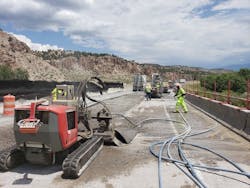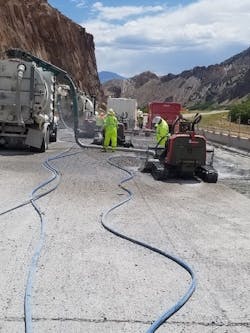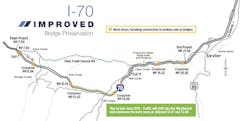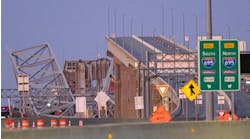Contractor uses robots to speed up Utah’s largest hydrodemolition bridge repair
By: Aaron Boerner
Infrastructure repair is a hot topic today, and rightfully so.
From potholes to deteriorating bridges, keeping up with repairs—and finding the money to do so—is a constant struggle. In an effort to complete jobs faster and win more bids, contractors are always looking for ways to speed up their processes while spending less. A hydro-blasting contractor working on a large bridge rehabilitation project underway in Utah is having success using a unique technique that fits the bill.
When Utah DOT (UDOT) officials noticed a number of bridges on I-70 between Cove Fort and Sevier with bridge decks showing signs of significant wear, they started the process of updating them. The 20-mile project includes replacing the concrete deck on 14 parallel bridges to extend the life of the structures and provide an improved driving surface. Paving crews then follow, overlaying the roadway with asphalt.
UDOT hired W.W. Clyde & Co. as the project’s general contractor. The company is a heavy civil construction firm based out of Orem, Utah. W.W. Clyde then hired Lyman, Wyoming based Redi Services for the bridge concrete removal portion.
The project was set to begin in April 2018 and be finished by the end of 2019. For this to happen, W.W. Clyde carefully choreographed the plan for maximum efficiency. This meant a critical path with little downtime built in and contractors rapidly moving in to complete work as soon as the previous step in the project was finished. Redi Services was tasked with the first step, removing the top half of the 8-in. concrete bridge deck.
A NEW METHOD
A highly efficient technique would be needed in order to remove concrete from 14 bridges in such a short span of time. UDOT officials conducted a study in 2016 and 2017 to determine what treatment could be used. They found the bridge deck damage was so pervasive that the traditional method of pothole patching would not be enough. As a result, UDOT officials decided on the less traditional method of hydrodemolition. The study found that using the technique would cost an estimated $14.4 million compared to $29.7 million to reconstruct the bridge decks and $300 million to replace the bridges entirely. The technique also would speed up the project, significantly reducing the number of days traffic would be impacted.
The report also found that hydrodemolition would give the bridge decks a life expectancy boost similar to a bridge deck replacement. UDOT officials say they anticipate hydrodemolition will extend the bridge decks’ lives by as much as 25 years.
GETTING GOING
Redi Services kicked off the I-70 project in April 2018 at the bridge above Clear Creek Canyon Road just east of Cove Fort. Work would continue east from there. It would be Utah’s largest hydrodemolition bridge deck project.
Armed with four Aquajet Aqua Cutter 710 robots rented from Jetstream, a Houston-based hydrodemolition equipment rental specialist, the contractor got to work. It would not be as easy as simply blasting away the concrete and letting the water and concrete debris flow away, however. UDOT set environmental protection as a No. 1 priority, and some of the bridges spanned Class A waterways, contamination of which could mean heavy fines and loss of eligibility to work on future government projects. Redi Services needed to retrieve all of the debris and used water, as well as recycle as much as possible.
To do this, the contractor set in place an efficient system of hydrodemolition, debris and water collection, filtration, and reuse. Operators used three robots simultaneously, with one serving as a backup in case of a breakdown. Crews directed hydrodemo machines spaced about 20 ft apart to remove 4 in.
of the 8-in. bridge deck concrete with 20,000 psi water jets, leaving 1 in. between the remaining concrete and the rebar. Together, the robots removed about 60 cu yd of concrete each day. Each machine jetted about 24,000 gal of water per 10-hour shift.
“The technique is extremely effective,” said Cody Austin, Redi Services Nevada area manager. “With chipping tools there is no way to know whether you are through all of the decomposed concrete. With these robots, the removal depth is always even. Plus, there’s almost no risk of damage to the rebar or the structurally sound concrete.”
To prevent any gray water from escaping, crews dammed up the storm collection box on the downhill end of the bridges, as well as any areas fugitive water could leak. The spent water flowed to the collection area where Vactor, Tornado, and Guzzler vacuum trucks sucked it up. Truck operators also followed the robots to remove as much standing water as possible and prevent it from evaporating and leaving concrete dust in the frequent 90° heat.
The vacuum trucks then sent the used water through a filtration equipment system that processed 150 gal/minute, first allowing debris to settle in a frac tank, then filtering the water, then conducting pH treatment. The cycle continued until the water was clean, at which point it was dumped into a 21,000-gal storage tank to be used by the robots again. Crews hauled any water that could not be reused to a settling pond; this amounted to only about 10,000 gal against 180,000 gal that were reused. Crews also hauled the concrete debris to a concrete plant where it was recycled.
KEEPING THE PACE
Workers followed with handheld breakers to even out any high spots after the robots completed a section. The high points most often occurred where the robots’ sections overlapped. Following concrete removal, crews sprayed the surface with pressure washers or fire hoses to wash away any remaining debris. After that, workers used sandblasters to remove any remaining rust from the rebar. Finally, the contractor used blowers to blow the sand off of the concrete and rebar to one end of the bridge, where it could be collected.
The contractor employed a 13-person crew on the job that worked 10-hour shifts with the robots, then spent two hours performing routine maintenance on the machines. This included cleaning, oiling and greasing the robots, looking for debris buildup, and replacing wear parts. Austin said they realized the importance of careful machine maintenance early on after two robots broke down around the same time. Fortunately, the rental supplier, Jetstream, worked hard to fix the issue within a few days. Redi Services was able to maintain the project pace during that time with a single robot working longer hours.
“It’s a good thing the supplier responded so quickly,” Austin said. “These machines take a beating as a result of the high-pressure water, so neglecting maintenance is a bad idea. We take good care of them and keep plenty of spare parts on hand.”
When possible, the contractor installs a median crossover to divert traffic off of a bridge and onto the parallel road, allowing crews to complete an entire structure at once. When finished, the traffic is diverted to the completed side to allow work on the opposite bridge. When that was not possible, crews just completed one lane at a time.
The median crossovers failed twice, pushing the project back a week each time. The delay was the result of needing to remove the hydrodemolition equipment from the bridge that was about to be worked on in order to reopen it to traffic during crossover repair.
STATUS REPORT
Redi Services did not need to set up any fall abatement systems because the bridge barriers remained in place during the project. However, the contractor did need to include special precautions as a result of the hydrodemolition robots. Though the robots’ water jets were surrounded by heavy rubber shielding, high-speed bits of concrete could still escape and fly hundreds of feet. To protect workers, traffic, and nearby structures, Redi Services installed 8-ft-tall barriers around the work zone. Crews also added extra rubber around the water jets. In addition, workers near the robots wore personal protective equipment, including rain suits, hard hats, impact gloves, safety glasses, face shields, and blast boots.
Following concrete removal, W.W. Clyde poured fresh deck concrete using concrete pumps and a roller screed. Weight restrictions meant the concrete truck had to be backed up to the end of the bridge, but not onto it. Using the screed, the contractor poured 2- to 3-ft sections of 3.75-in. concrete. Workers followed close behind, using handheld needle vibrators to consolidate the new concrete and remove voids, as well as to ensure the most effective bonding to the moonscape-like surface. UDOT officials checked slump and air during the process. Once poured, the concrete cured for 10-15 days before W.W. Clyde added a fresh asphalt overlay and striping. Redi Services wrapped up its portion of all 14 bridges in August 2019. The total project wraps up in late 2019. The contractor saved an estimated 1 million gal of water as a result of recycling, equal to about 63 below-ground backyard swimming pools. Workers removed about 3,300 cu yd of concrete, most of which was also recycled.
“Hydro-blasting contractors used to have a reputation for being wasteful and not doing much to catch and treat the wastewater,” Austin said. “UDOT officials were impressed with our collection and recycling efforts. They’ve told us they expect there will be a lot more hydrodemolition jobs on the horizon.”
About The Author: Boerner writes for the construction, demolition, landscaping, and mining/aggregates industries.





